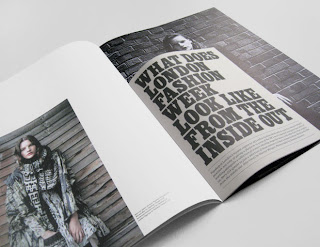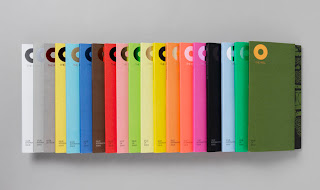We just had our first meeting with the Fine Art team to discuss ideas for the yearbook, and to ask some questions.
Considering the concept - they weren't too struck with the thirsty concept and the imagery we had used, as to them it seemed to narrative. They had their own concept/title for the exhibition which is, 'Original Rework', which vaguely means that everything has been down before but that they take their understanding of history and they 'rework' it and create their own original artwork.
The yearbook will be used for the LCA exhibition and also for the Free Range exhibition in London. For this they usually reference the London exhibition as 'Touring to:' The designs need to promote them, make them stand out and represent who they are as a course. They felt that last years yearbook was too typographical and that they prefer imagery on the cover, and they felt a bit lost at exhibition. Collateral will include yearbooks and possibly posters, leaflets and we also discussed bags for the printed materials to be carried in.
With regards to the yearbook. They had a few issues that need to be addressed. They liked the previous rectangle sized format over the 210 x 210mm square format as they feel it was more practical to carry. However the previous yearbooks of this size didn't have as many students so if they went with the double page spread for each student, then the book would be quite thick, as their are now 56 students (so that would be 112 pages) and they felt that this would lose the practical side to it, as they don't want it to be too bulky. The only way around this would be to use single pages for each student, but this obviously would not show off their work as well as a double. They asked for us to try and bring mock-ups to give them a feel of the double page spread thickness. We then showed them a landscape version of the rectangular shape, of which they seemed to like as they haven't used that format before. The landscape format would work well if the students were having single pages as the left and right pages seem more separate than on a portrait double spread. Also, they do not want any fold out pages and they do prefer to have spines rather than staples, with the text on the information on the spine too. We need to specify the number of pages that could be used for single and double page spread as they usually work in 16 page multiples - so we would have to let them know how many pages would be left over and what they could do with them.
They want to yearbook to be in full colour rather than black and white as they feel this best shows off their work. They would ideally like to use one image per student to sum them up. So for this we will need to specify to the students the quality of image, resolution, colour mode, file size, scale ratio. As they will be gathering the photos themselves before getting them to us. We gave them a deadline for everything they want in the book to get to us before Easter. But we are going to discuss creating a timeline for us and FA to work to, and push deadlines forward to get the project moving quicker so we can start designing and putting the yearbook together. But for now we will have to use image of previous work and dummy text.
They brought with them a piece of design work (Creamier - contemporary art in culture) that they were inspired by, which was quite typographical on the cover with text in black varnish, and the content was a newspaper style. The stock felt quite like newsprint but it seemed a bit better quality and the images printed were very high quality. The colour of the stock was pale orangey quite like the financial times newspaper, it was also unite thin, which means it would bring the thickness of the book down. They like the idea of having thin glossy stock as the colour of the images have more impact. They also like magazine format, which means the size would show off their work better yet wouldn't be too bulky due to the low gsm stock.
The student name could work in alphabetical order or it could just be what colour in the images work best next to each other. The content page could have the names in alphabetical order, so the students are easy to navigate and then the page numbers next to the names doesn't necessarily have to be in the right order - just were abouts they are in the book.
The information included will be the course philosophy, and on each student pages; their name, a 30-40 word summary of their work, their email address, website (if applicable) but no phone numbers. They would also like to include quotes off members of staff and professionals to give a feel for the course, however they are going to get back to us on who these quotes will be from.
They have gone away to further discuss their 'Original Rework' concept tight the rest of the year group and are going to get back to us at some point today so we can start to use this concept and come up with ideas on how to work with it, how it could work technically and ideas for the cover.
They do not want text over the image as they feel they detract front images. Typeface will follow from the concept.
We are going to meet up on Monday mornings to discuss progress each week. Depending on where we are up to we may need to meet up more than once each week, to keep them up to date.
To do:
- Specify page number - how many are going to be left over after 56 students double/single pages
- Stock options - what is best for high quality images but also to be quite thin.
- 'Original Rework' ideas
- Create a timeline - deadlines and project management - student images and 30-40 word statements
- Find out budget - and quantity of yearbook needed
- Format options - landscape, portrait (rectangular) - or does it have to be the 210 x 210 mm
































































